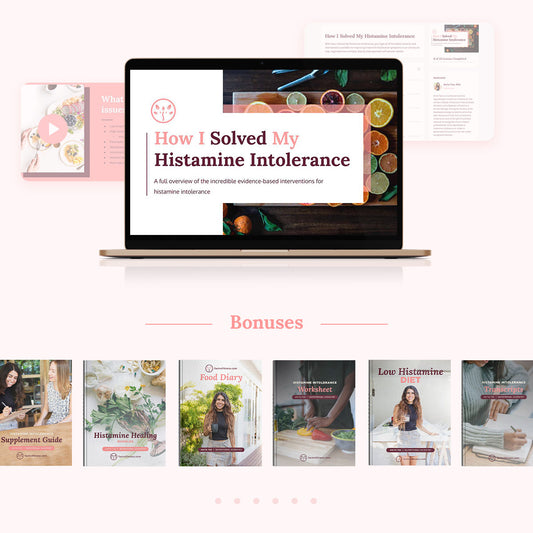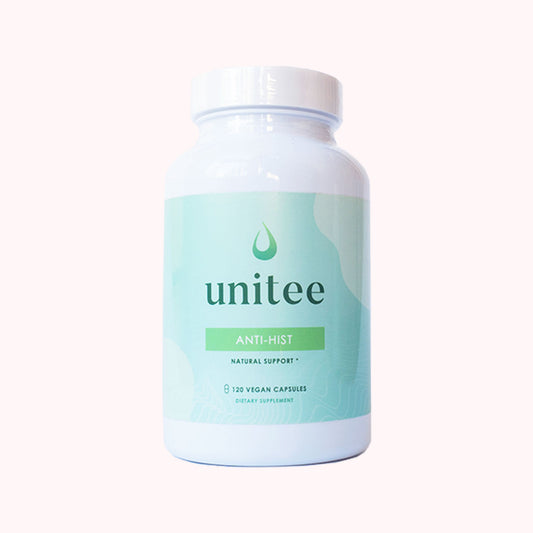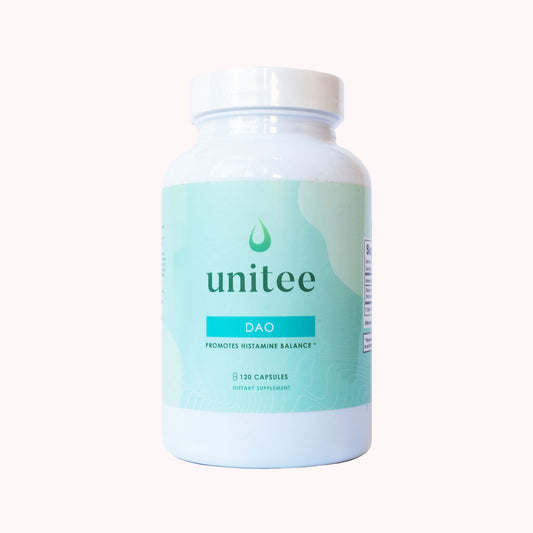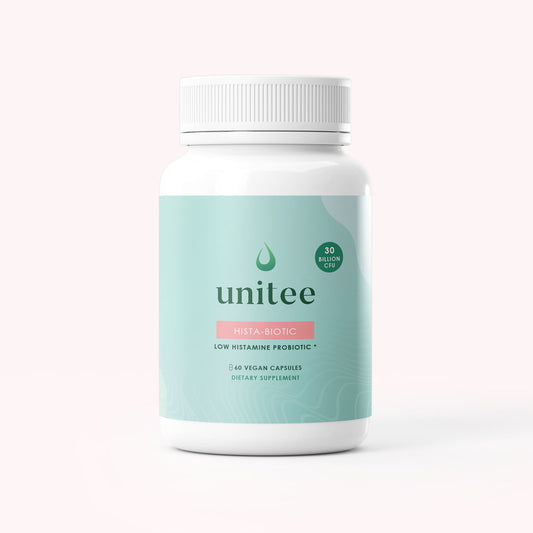Could your pain medication be contributing to your histamine symptoms? Let's find out...
We all use them here and there. Many of them we can buy over the counter. They offer relief from everyday aches and pains, making our stressful, pain-inducing lives more bearable. They come in all shapes and forms and some of them can even be addictive. Yes, I’m talking about painkillers. While they may bring relief to your pounding headache, they may be doing more harm than good when it comes to your histamine intolerance.
Painkillers: Types, Uses and Differences
The function is in the name - painkillers are used to control pain. There are only three main types of pain medication, but many different brands. They come in all shapes and sizes and can be taken in different ways, by mouth as syrups, tablets or capsules, by injection or as a suppository (1). The three types of painkillers work in different ways.
Non-steroidal anti-inflammatories (NSAIDs) such as ibuprofen, diclofenac and naproxen, relieve pain by blocking cyclooxygenase (COX) enzymes. This is useful because COX enzymes are responsible for the production of prostaglandins which cause pain and inflammation in sites in the body that have been damaged or injured (2).
Paracetamol is still a bit of a mystery in the pharmacology world - believe it or not, nobody seems to be able to figure out exactly how it works! The experts suspect that it may also block the COX enzymes and work in a similar manner to NSAIDs (1).
Opioids are very effective pain relievers that include morphine, codeine, and oxycodone. Although they work well for pain relief, they are strictly controlled because they are potentially addictive. They bind with opioid receptors in the nervous system, generating a series of signals which result in reduced cell excitability and transmission of nerve impulses (3).
Many NSAIDs and paracetamol can be purchased over the counter and we tend to use them for general, everyday aches and pains. Opioids are highly regulated and require a prescription (1).
Whichever one is your go-to for pain relief, do you know what other effects it is having in your body?
Painkillers and How They Influence Histamine Intolerance
The first place we need to look is at the gut microbiome - all of the trillions of bacteria living in your gut. They play a big role in keeping our gut and our immune system healthy. We need to encourage the growth of these friendly bacteria to maintain the integrity of the gut wall (4).
This is where our painkillers come into play. NSAIDs, in particular, have been shown to have both a direct and an indirect impact on the gut microbiome. They can inhibit or encourage the growth of certain strains of bacteria, they can cause the death of the microbes or they can change the way the bacteria metabolise food and drugs (4).
The indirect impact comes from an interaction with the host (the human). Our own metabolism can be affected by NSAIDs and they can change the environment within our intestines, making it more or less beneficial for the bacteria.
But perhaps most important when we are looking at the link between painkillers and histamine intolerance is the fact that they can make the gut more permeable. In other words, larger molecules and greater numbers of substances can pass unaided through the intestinal wall, into our bodies (4). And that includes histamine.
This issue can highlight how painkillers may contribute to your histamine intolerance symptoms, and why some of those symptoms may involve digestive issues and food sensitivities.
Some painkillers and anti-inflammatory drugs also cause an increase in histamine release in people who battle with allergies (5).
Not looking too good for your histamine intolerance so far, is it?
And, unfortunately, it gets worse. It is not only the non-steroidal anti-inflammatory drugs that cause the release of histamine, opioid drugs have also been shown to be “potent histamine releasers”. In one scientific study the researchers showed that wheals caused by the administration of morphine were resolved when the patient was given an antihistamine, thus confirming that a histamine reaction is triggered by opioids (6).
All of those symptoms you experience when taking painkillers is not just in your head! If you have histamine intolerance, they may be responsible for making it worse.
3 Ways to Stop Symptoms of Histamine Intolerance Developing When Using Pain Medication
It is not practical to simply avoid taking painkillers. So, apart from taking an antihistamine with your go-to pain medication, how do you avoid having an adverse reaction to the increased histamine load?
There are a few options to consider, which I will detail below:
1. Natural painkiller alternatives - There are actually many natural alternatives to painkillers. Although these may not be as powerful as the opioid class, in particular, some of them work excellent for everyday pain. One example is using a potent curcumin supplement, which acts as both a natural painkiller and anti-inflammatory. Curcumin also helps to reduce histamine levels, which means you may not only experience pain relief, but relief from your histamine symptoms, too.
Another natural painkiller is a magnesium supplement, which works particularly well for muscle pains and menstrual cramps (especially if taken in the days leading up to your period, as well). There are also other alternative options such as osteopathic or physiotherapy treatments that can help to manage the pain through physical manipulation and particular exercises.
2. Follow a low histamine diet - Whether or not you opt for natural painkillers or over-the-counter (OTC) ones from a pharmacy, you're going to want to follow a low histamine diet to ensure your histamine levels remain in check and you don't get histamine symptoms. Remember, histamine symptoms come from having too much histamine in the body - meaning that, even if you have something that contains or increases histamine levels, such as a prescription or OTC painkiller, you're much less likely to get a reaction if you have low baseline histamine levels. Click below to get my free low histamine diet which will tell you exactly what to eat and avoid to reduce symptoms!
Remember, if you are constantly eating foods that have high histamine content, or foods that result in the release of histamine, your body is constantly having to make an effort to control your histamine levels. If your histamine levels are constantly high, you are constantly sitting at the threshold of a negative reaction. So, when you have a headache and you swallow your ibuprofen, you end up feeling worse, rather than feeling better (7).
3. Attend to the root cause of your pain - This option is easier said than done, and may not be fully possible for everyone. Some individuals do have lifelong conditions that they may not fully be able to resolve, which does make pain management the bigger focus than resolution. However, in any case knowing the root cause will provide you with the power to search for better therapies that can target pain at a deeper level - whether that means to manage or fully resolve it. Consulting experts such as specialized doctors and naturopaths, osteopaths, physiotherapists, and other individuals that can help you to understand your pain will lead you down the correct path.
A personal story: I had pain for several years in my right wrist, forearm, upper arm, neck and upper back. The pain arose shortly after I had experienced a fall and minor wrist injury doing acrobatics. It slowly progressed to the point that, some days, I was unable to even sit up on my own due to the excruciating pain. I tried doing physical exercises and seeing a variety of professionals - but, nothing could fully resolve it.
One day, the pain became so extreme I could not even dress myself. I went to the emergency room and, still, we were unable to understand why the issue was there as my wrist from the acrobatics injury appeared to be fully healed and I was even told several times it was in my head and was a "phantom" pain.
Somehow, my husband took a stab in the dark and suggested it may be stemming from my teeth. I have always had very large teeth and I had told him stories about how the dentist wanted to remove some teeth when I was younger due to crowding in my mouth. As I was in the emergency room doing testing, he found an emergency dentist that could take me the next day.
After some X-rays and additional testing, the dentist explained I had an impacted wisdom tooth that was causing pressure on my nerve and a recurring infection. He injected me with an antibiotic that, within an hour, caused the pain down the right side of my body to subside.
We were confident we had finally found the issue so the next week had my wisdom teeth removed and - since then - the pain has been fully gone and years of suffering and money spent on trying to find the root cause was finally over. No other specialist had suspected it was from a tooth, and I had never thought I would find the answer at the dentist!
As you can see from this little anecdote, sometimes we really find the answer in an unexpected place, and an unexplainable pain can become resolvable or better managed. This story applies to both chronic and transient pain - whether it's an ongoing "phantom" pain or common monthly menstrual cramps, finding the answer will give you power.
I hope these tips and this story helps you to think twice next time you feel a twinge of pain and are reaching for the medicine cabinet. Be sure to truly consider the steps above and attend to all 3 of them to ensure the best results for your body and your wellbeing.
References:
- Rull D. Painkillers | What are they and how do they work? Patient.info. 2021.
- Wöhrl S. NSAID hypersensitivity – recommendations for diagnostic work up and patient management. Allergo Journal International. 2018;27(4):114-121.
- Opioids. PubMed. 2021.
- Maseda D, Ricciotti E. NSAID–Gut Microbiota Interactions. Frontiers in Pharmacology. 2020;11.
- Histamine Intolerance. Information for Medical Professionals. Histamineintolerance.org.uk. 2021.
- Baldo B, Pham N. Histamine-Releasing and Allergenic Properties of Opioid Analgesic Drugs: Resolving the Two. Anaesthesia and Intensive Care. 2012;40(2):216-235.
- Maintz L, Novak N. Histamine and histamine intolerance. The American Journal of Clinical Nutrition. 2007;85(5):1185-1196.

Anita Tee
My name is Anita Tee. I'm a nutritional scientist specializing in histamine intolerance. I hold a Master of Science in Personalized Nutrition and a Bachelor of Science in Human Biology and Psychology. For the past ten years, I have used my experience in nutritional and medical health sciences to create a scientifically backed, natural approach to healthcare that relies 100% on evidence-based research. As I previously suffered from - and overcame - histamine intolerance, my focus is to increase recognition and expand the available resources and protocols for resolving the disorder. To date, I have helped over 4,000 individuals fully resolve or better manage their histamine intolerance symptoms.







